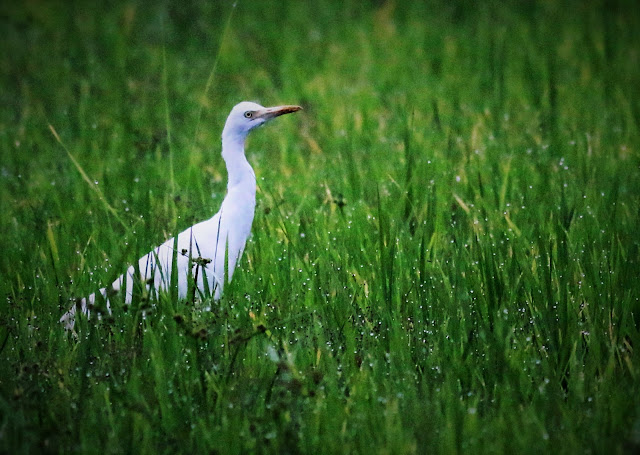"Paddy becomes rice after the removal of its husk by threshing. Therefore, rice is a part of paddy. Paddy is the rice grain with husk.
The term paddy was derived from the Malay word "Padi" which means “rice in the
straw or husk”. Rice is the seed of paddy. Generally, rice plant also is
called paddy. This is a crop which belongs to the family Graminae. Botanical
name of the paddy is Oryza sativa. It is a staple food of the majority
of the world population. It is the second major crop in the world"
When you travel around Peninsular Malaysia especially before the harvest season, you can be treated with some spectacular views of the paddy fields. Along with the views you can also find yourself with some of the birds which you may be hoping to see. Here are some of the common birds which can be found around the paddy fields in the west coast of Peninsular Malaysia.

Those little white spots in the above photo were dews / water droplets. This photo was taken in the early morning - about 7.30am.
Black-Shouldered Kite are also common in paddy fields as well as around open grass lands.
At times you may also come across some Intermediate Egrets. Just wonder how it has kept its feathers so clean and white.
Another common bird which you may find foraging in paddy fields are the pond herons. Apparently all three types of pond heron (Chinese, Indian and Javan ) do occur in the paddy fields here and they are virtually indistinguishable in the field during non-breeding season.
Some field reports however described that Chinese Pond Heron is slightly larger than the Indian Pond Herons and Javan Pond Herons. While the smallest of em all is the Indian Pond heron.
This pond heron is noticeably smaller than the earlier one. Although i do not discount that it could have been a juvenile but based on its features - blue lore, shorter wingspan and bolder neck stripes, this could have been an Indian Pond Heron.
White-Rumped Munia are also common in the paddy fields
Striated heron has been a very adaptive bird lately
Black-Winged Stilt can at times be as common in certain paddy fields.
Once the paddy fields are cropped the scene can be significantly different but the common birds will still be around.
Could this be a pseudo Collared Crow or a real thing?
When you go birding in the paddy fields, don't forget to bring plenty of your sun block with appropriate SPF properties.































































